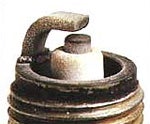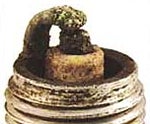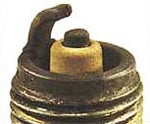Curious About Your Engine’s Health? Check Your Spark Plugs
Spark plugs reveal plenty about your engine
Spark plugs are the key to the whole “internal-combustion” process, so it only makes sense that their condition indicates a little bit about what’s going on in your engine. Their color, their physical condition, even the gap between the electrodes speaks volumes to those who know what they’re looking for.
Ready to expand your knowledge? Experts suggest putting the following four notes on your checklist:
Check the color
In order to function properly, the temperature at a spark plug’s tip needs to remain between 500C-850C. Colder than that and the insulator will be too chilly to burn off carbon and combustion chamber deposits; too hot and the ceramic around the electrode will blister, and the electrodes ultimately melt. The result will be pre-ignition and detonation.


Check the color of the plug’s “firing” end to get a glimpse into your engine’s health. Ideally, both the porcelain and the electrode should have a light tan to grayish hue. If the insulator is glazed or glossy it’s a sign that the engine is running too hot. A black, oily plug is a sign of fouling, often the result of an air/fuel ratio that is too rich, or problems with the fuel-injection system.
Look for damage
Inspect the porcelain. If it’s breaking away, your engine is experiencing excessive detonation, often caused by too low octane in your fuel. If the electrode looks bent, it’s been struck from within. The plug may not be the correct length for your particular engine, or something is lurking within your engine.
If either the center or ground electrode looks “melted,” it’s a sign or pre-ignition problems. Check that your plug is the proper heat range for your engine. Your engine’s timing may also be too far advanced. Rule out those problems? Double-check your fuel’s octane rating to make sure it’s not too low, and make sure your cooling system is working properly.
Measure the gap

Few owners likely ever check a plug’s gap, the distance between the ground electrode and the center electrode, when replacing plugs. Conventional wisdom is that it’s set correctly at the factory. But as it directly affects the plug’s tip temperature, the proper gap is key to your engine’s performance.
Check your owner’s manual for individual gap specifications, then check plug gap using a wire-style or other professional spark plug gap tool. Better models will have a tab to grab onto the ground electrode, and never contact the center electrode. Avoid cheap, coin-style gap wheels, as they can break off the center electrode, especially on pricey fine-wire platinum and iridium spark plugs.
Don’t feel up to the task? Stop by your local shop, and ask them to check the gap for you.
Use torque
As in a torque wrench. Sure, most of us just crank spark plugs in, but if you’re too tight you risk fracturing the insulator. Too loose and you’ll slow heat transfer, elevating internal temperatures.
Consult your manual to get the correct tightening specs, and use a torque wrench to do the job properly.
Get PersonalWatercraft.com in your Inbox!
Like PersonalWatercraft.com on Facebook
Comments
Most Popular

2025 Yamaha JetBlaster PRO 2-Up Review

2024 Kawasaki Jet Ski STX 160X Review

Remembering the Sea-Doo XP

Whatever Happened to the Wetbike?

2025 Yamaha JetBlaster Review











 Your Privacy Choices
Your Privacy Choices